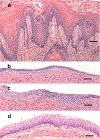More than keratitis, ichthyosis, and deafness: Multisystem effects of lethal GJB2 mutations
- PMID: 30287322
- PMCID: PMC6372339
- DOI: 10.1016/j.jaad.2018.09.042
More than keratitis, ichthyosis, and deafness: Multisystem effects of lethal GJB2 mutations
Abstract
Background: Infant death in keratitis-ichthyosis-deafness (KID) syndrome is recognized; its association with specific genotypes and pathophysiology is inadequately understood.
Objective: We sought to discover characteristics that account for poor outcomes in lethal KID syndrome.
Methods: We collected 4 new cases and 9 previously reported, genotyped cases of lethal KID syndrome. We performed new molecular modeling of the lethal mutants GJB2 p.A88V and GJB2 p.G45E.
Results: Infant death occurred in all patients with GJB2 p.G45E and p.A88V; it is unusual with other GJB2 mutations. Early death with those 2 "lethal" mutations is likely multifactorial: during life all had ≥1 serious infection; most had poor weight gain and severe respiratory difficulties; many had additional anatomic abnormalities. Structural modeling of GJB2 p.G45E identified no impact on the salt bridge previously predicted to account for abnormal central carbon dioxide sensing of GJB2 p.A88V.
Limitations: This clinical review was retrospective.
Conclusion: GJB2 p.G45E and p.A88V are the only KID syndrome mutations associated with uniform early lethality. Those electrophysiologically severe mutations in GJB2 reveal abnormalities in many organs in lethal KID syndrome. All patients with KID syndrome may have subtle abnormalities beyond the eyes, ears, and skin. Early genotyping of KID syndrome births will inform prognostic discussion.
Keywords: connexin 26; gap junction protein, beta-2; keratitis, ichthyosis, and deafness syndrome.
Copyright © 2018 American Academy of Dermatology, Inc. All rights reserved.
Conflict of interest statement
Figures



References
-
- Gilliam A, Williams ML. Fatal septicemia in an infant with keratitis, ichthyosis, and deafness (KID) syndrome. Pediatr Dermatol 2002;19:232–6. - PubMed
-
- Koppelhus U, Tranebjaerg L, Esberg G, Ramsing M, Lodahl M, Rendtorff ND et al. A novel mutation in the connexin 26 gene (GJB2) in a child with clinical and histological features of keratitis-ichthyosis-deafness (KID) syndrome. Clin Exp Dermatol 2011;36:142–8. - PubMed
-
- Jonard L, Feldmann D, Parsy C, Freitag S, Sinico M, Koval C et al. A familial case of Keratitis- Ichthyosis-Deafness (KID) syndrome with the GJB2 mutation G45E. Eur J Med Genet 2008;51:35–43. - PubMed
-
- Sbidian E, Feldmann D, Bengoa J, Fraitag S, Abadie V, de Prost Y et al. Germline mosaicism in keratitis-ichthyosis-deafness syndrome: pre-natal diagnosis in a familial lethal form. Clin Genet 2010;77:587–92. - PubMed
MeSH terms
Substances
Supplementary concepts
Grants and funding
LinkOut - more resources
Full Text Sources
Medical
Miscellaneous

